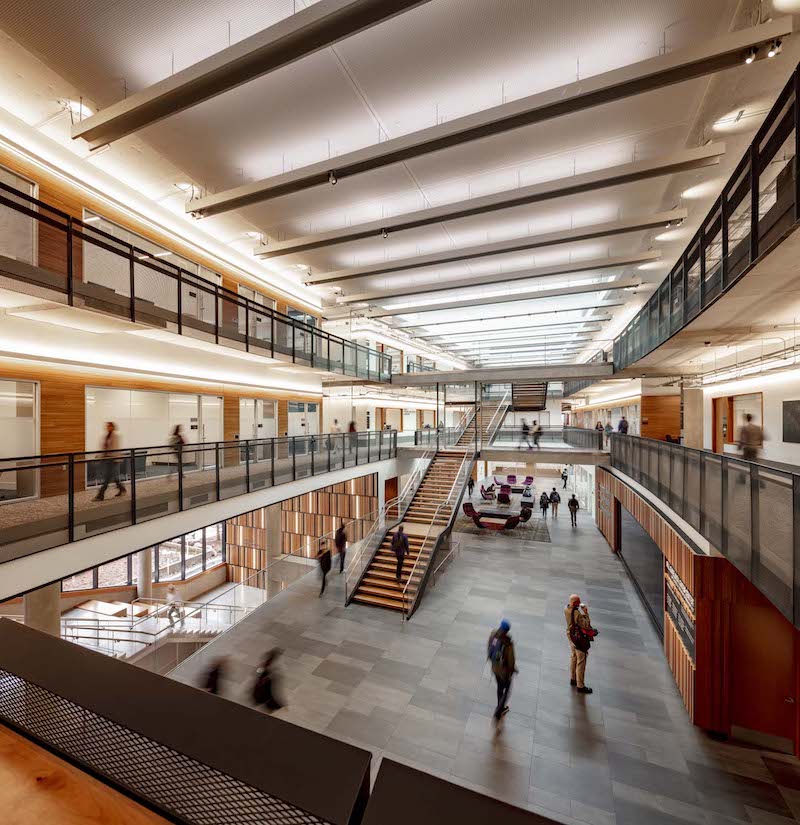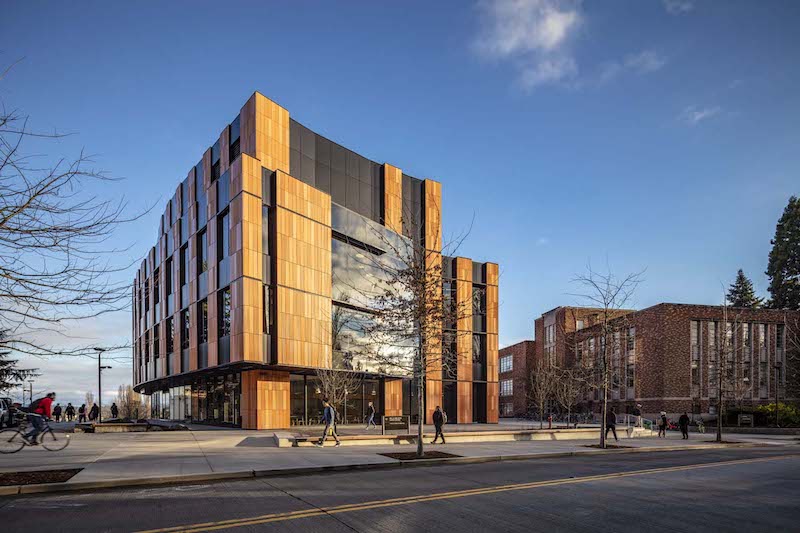Since 2003, the University of Washington’s Paul G. Allen School of Computer Science and Engineering has grown considerably. The program outgrew the existing 165,000 sf building and found itself needing more space.
Enter the Bill & Melinda Gates Center for Computer Science & Engineering. Designed by LMN Architects, the 140,000-sf facility expands the current capacity of the school and provides research spaces, classrooms and lecture spaces, faculty offices, and a new home for the School’s undergraduate majors. A central, naturally-lit atrium provides visual and physical connections to all the floors and acts as the school’s central hub. At the roof-level, an event center will support a wide range of educational needs, industry collaborations, and outreach functions. A cafe activates the primary entry and acts as a transition between the exterior landscape to the central atrium.

The building’s exterior features a two-sided curving form that responds to the site’s topography and the flow of campus circulation. The building’s facade system of terra cotta panels in four texture types acts as a juxtaposition against the modern black glass and metal.
See Also: University of Arizona Student Success District begins construction
The completed project is targeting LEED New Construction Silver.
Related Stories
| Nov 3, 2014
An ancient former post office in Portland, Ore., provides an even older art college with a new home
About seven years ago, The Pacific Northwest College of Art, the oldest art college in Portland, was evaluating its master plan with an eye towards expanding and upgrading its campus facilities. A board member brought to the attention of the college a nearby 134,000-sf building that had once served as the city’s original post office.
| Oct 16, 2014
Perkins+Will white paper examines alternatives to flame retardant building materials
The white paper includes a list of 193 flame retardants, including 29 discovered in building and household products, 50 found in the indoor environment, and 33 in human blood, milk, and tissues.
| Oct 15, 2014
Harvard launches ‘design-centric’ center for green buildings and cities
The impetus behind Harvard's Center for Green Buildings and Cities is what the design school’s dean, Mohsen Mostafavi, describes as a “rapidly urbanizing global economy,” in which cities are building new structures “on a massive scale.”
| Oct 14, 2014
Proven 6-step approach to treating historic windows
This course provides step-by-step prescriptive advice to architects, engineers, and contractors on when it makes sense to repair or rehabilitate existing windows, and when they should advise their building owner clients to consider replacement.
| Oct 12, 2014
AIA 2030 commitment: Five years on, are we any closer to net-zero?
This year marks the fifth anniversary of the American Institute of Architects’ effort to have architecture firms voluntarily pledge net-zero energy design for all their buildings by 2030.
| Sep 24, 2014
Architecture billings see continued strength, led by institutional sector
On the heels of recording its strongest pace of growth since 2007, there continues to be an increasing level of demand for design services signaled in the latest Architecture Billings Index.
| Sep 22, 2014
4 keys to effective post-occupancy evaluations
Perkins+Will's Janice Barnes covers the four steps that designers should take to create POEs that provide design direction and measure design effectiveness.
| Sep 22, 2014
Sound selections: 12 great choices for ceilings and acoustical walls
From metal mesh panels to concealed-suspension ceilings, here's our roundup of the latest acoustical ceiling and wall products.
| Sep 17, 2014
New hub on campus: Where learning is headed and what it means for the college campus
It seems that the most recent buildings to pop up on college campuses are trying to do more than just support academics. They are acting as hubs for all sorts of on-campus activities, writes Gensler's David Broz.















